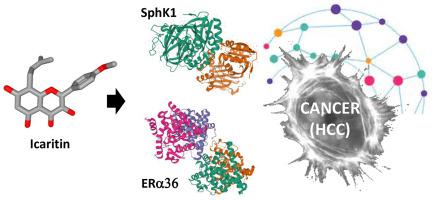当前位置:
X-MOL 学术
›
Chem. Biol. Interact.
›
论文详情
Our official English website, www.x-mol.net, welcomes your
feedback! (Note: you will need to create a separate account there.)
Molecular and cellular basis of the anticancer activity of the prenylated flavonoid icaritin in hepatocellular carcinoma.
Chemico-Biological Interactions ( IF 4.7 ) Pub Date : 2020-05-11 , DOI: 10.1016/j.cbi.2020.109124 Christian Bailly 1
Chemico-Biological Interactions ( IF 4.7 ) Pub Date : 2020-05-11 , DOI: 10.1016/j.cbi.2020.109124 Christian Bailly 1
Affiliation

|
The prenylated flavonoid icaritin (ICT) is currently undergoing phase 3 clinical trial for the treatment of advanced hepatocellular carcinoma (HCC), based on a solid array of preclinical and clinical data. The antitumor activity originates from the capacity of the drug to modulate several signaling effectors in cancer cells, mainly the estrogen receptor splice variant ERα36, the transcription factors STAT3 and NFκB, and the chemokine receptor CXCR4. Recent studies have implicated additional components, including different microRNAs, the generation of reactive oxygen species and the targeting of sphingosine kinase-1. ICT also engages the RAGE-HMGB1 signaling route and modulates the apoptosis/autophagy crosstalk to promote its anticancer activity. In addition, ICT exerts profound changes on the tumor microenvironment to favor an immune-response. Collectively, these multiple biochemical and cellular characteristics confer to ICT a robust activity profile which can be exploited to treat HCC, as well as other cancers, including glioblastoma and onco-hematological diseases such as chronic myeloid leukemia. This review provides an update of the pharmacological properties of ICT and its metabolic characteristics. It also addresses the design of derivatives, including both natural products and synthetic molecules, such as SNG1153 also in clinical trial. The prenylated flavonoid ICT deserves attention as a multifunctional natural product potentially useful to improve the treatment of advanced hepatocellular carcinoma.
中文翻译:

异戊烯基黄酮类二十烷酸抗肝癌活性的分子和细胞基础。
基于临床前和临床数据的坚实基础,该异戊烯基类黄酮素(ICT)目前正在接受治疗晚期肝细胞癌(HCC)的3期临床试验。抗肿瘤活性源自该药物调节癌细胞中几种信号传导因子的能力,主要是雌激素受体剪接变体ERα36,转录因子STAT3和NFκB以及趋化因子受体CXCR4。最近的研究暗示了其他成分,包括不同的microRNA,活性氧的产生和鞘氨醇激酶1的靶向。ICT还参与RAGE-HMGB1信号传导途径,并调节细胞凋亡/自噬串扰,以增强其抗癌活性。此外,ICT对肿瘤微环境产生了深远的影响,以促进免疫反应。总的来说,这些多种生化和细胞特征赋予ICT强大的活动特征,可用于治疗HCC以及其他癌症,包括成胶质细胞瘤和肿瘤血液学疾病,例如慢性粒细胞白血病。这篇评论提供了ICT的药理特性及其代谢特性的更新。它还处理了包括天然产物和合成分子在内的衍生物的设计,例如也在临床试验中的SNG1153。烯丙基化类黄酮ICT作为一种多功能天然产物值得关注,它可能对改善晚期肝细胞癌的治疗有用。包括胶质母细胞瘤和肿瘤血液系统疾病,例如慢性粒细胞白血病。这篇评论提供了ICT的药理特性及其代谢特性的更新。它还处理了包括天然产物和合成分子在内的衍生物的设计,例如也在临床试验中的SNG1153。烯丙基化类黄酮ICT作为一种多功能天然产物值得关注,它可能对改善晚期肝细胞癌的治疗有用。包括胶质母细胞瘤和肿瘤血液系统疾病,例如慢性粒细胞白血病。这篇评论提供了ICT的药理特性及其代谢特性的更新。它还处理了包括天然产物和合成分子在内的衍生物的设计,例如也在临床试验中的SNG1153。烯丙基化类黄酮ICT作为一种多功能天然产物值得关注,它可能对改善晚期肝细胞癌的治疗有用。
更新日期:2020-05-11
中文翻译:

异戊烯基黄酮类二十烷酸抗肝癌活性的分子和细胞基础。
基于临床前和临床数据的坚实基础,该异戊烯基类黄酮素(ICT)目前正在接受治疗晚期肝细胞癌(HCC)的3期临床试验。抗肿瘤活性源自该药物调节癌细胞中几种信号传导因子的能力,主要是雌激素受体剪接变体ERα36,转录因子STAT3和NFκB以及趋化因子受体CXCR4。最近的研究暗示了其他成分,包括不同的microRNA,活性氧的产生和鞘氨醇激酶1的靶向。ICT还参与RAGE-HMGB1信号传导途径,并调节细胞凋亡/自噬串扰,以增强其抗癌活性。此外,ICT对肿瘤微环境产生了深远的影响,以促进免疫反应。总的来说,这些多种生化和细胞特征赋予ICT强大的活动特征,可用于治疗HCC以及其他癌症,包括成胶质细胞瘤和肿瘤血液学疾病,例如慢性粒细胞白血病。这篇评论提供了ICT的药理特性及其代谢特性的更新。它还处理了包括天然产物和合成分子在内的衍生物的设计,例如也在临床试验中的SNG1153。烯丙基化类黄酮ICT作为一种多功能天然产物值得关注,它可能对改善晚期肝细胞癌的治疗有用。包括胶质母细胞瘤和肿瘤血液系统疾病,例如慢性粒细胞白血病。这篇评论提供了ICT的药理特性及其代谢特性的更新。它还处理了包括天然产物和合成分子在内的衍生物的设计,例如也在临床试验中的SNG1153。烯丙基化类黄酮ICT作为一种多功能天然产物值得关注,它可能对改善晚期肝细胞癌的治疗有用。包括胶质母细胞瘤和肿瘤血液系统疾病,例如慢性粒细胞白血病。这篇评论提供了ICT的药理特性及其代谢特性的更新。它还处理了包括天然产物和合成分子在内的衍生物的设计,例如也在临床试验中的SNG1153。烯丙基化类黄酮ICT作为一种多功能天然产物值得关注,它可能对改善晚期肝细胞癌的治疗有用。

















































 京公网安备 11010802027423号
京公网安备 11010802027423号